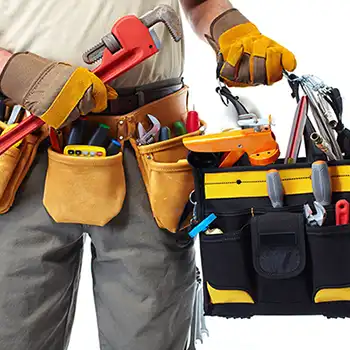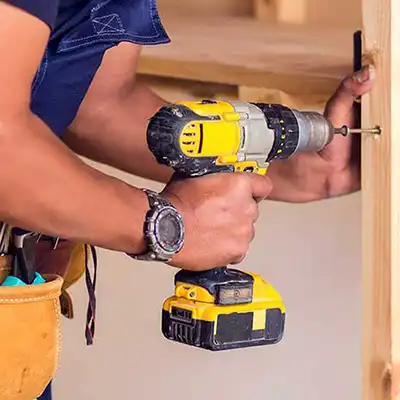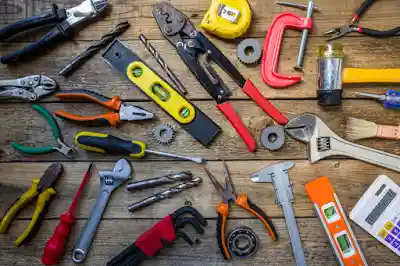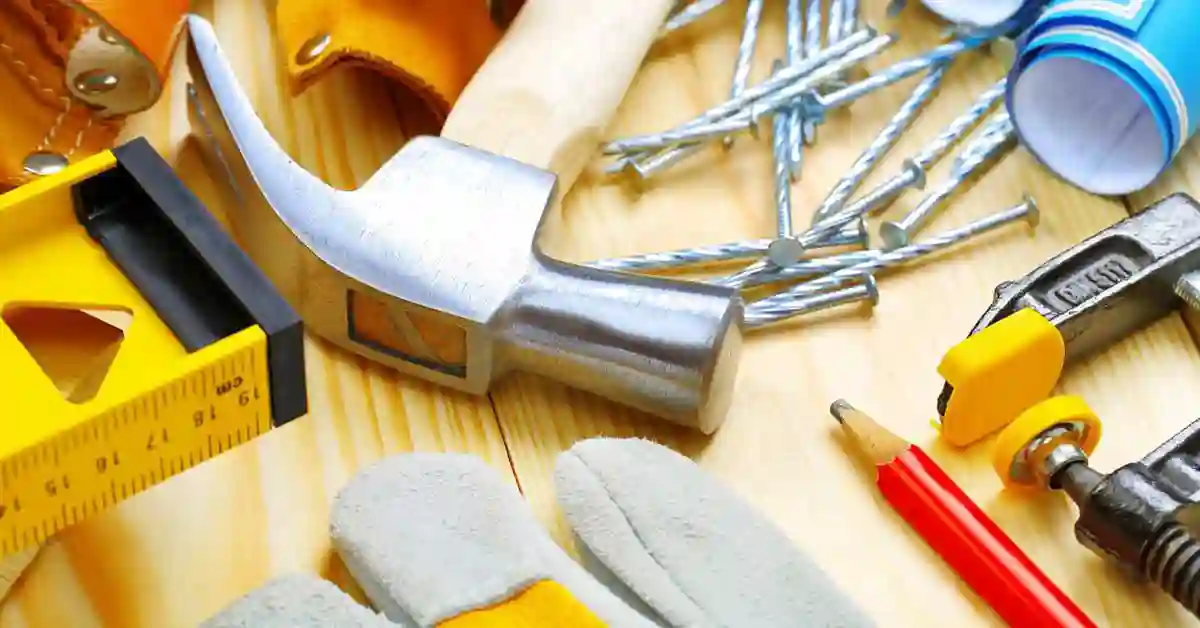Starting a handyman business or updating your existing toolkit? Having the best handyman tools is crucial for providing quality service and building a reputation for reliability. Whether you're a seasoned professional or just starting, this guide will help you assemble the perfect handyman tool kit.
Why the Best Handyman Tools Matter
In the handyman business, your tools are your livelihood. The quality and variety of your tools can directly impact your efficiency, the quality of your work, and ultimately, your customer satisfaction. Investing in the best tools for a handyman not only enhances your capabilities but also helps you tackle a wider range of jobs.
Keep in mind that technology is a tool as well. Robust handyman software will help streamline your business operations.
Impact on Efficiency and Quality
Having the right tools means you can complete jobs faster and with greater precision. Efficiency isn't just about speed, it's about delivering quality work without wasting time. Proper tools allow you to execute tasks with precision, reducing errors and the need for rework.
Building Customer Trust and Satisfaction
Customers value reliability and skill. When you show up equipped with the right tools, it demonstrates professionalism and preparedness. This not only builds trust but also enhances your reputation, leading to repeat business and referrals.
Expanding Service Capabilities
With a diverse toolkit, you can take on a wider variety of jobs. This flexibility can help you cater to different customer needs, from simple fixes to complex renovations. Expanding your service offerings can lead to increased opportunities and growth for your handyman business.

Handyman Tools List: Must-Have Basics
Before diving into specialized equipment, ensure you have the basics covered. These are the foundational tools every handyman should own.
1. Measuring Tape
A reliable measuring tape is essential for any handyman. From installing shelves to cutting materials, precise measurements are crucial. Look for a tape measure that is durable and easy to read.
Importance of Precision
Precision in measurement is the cornerstone of quality work. Inaccuracies can lead to improper fitting and wasted materials, affecting the project's overall success. A good measuring tape ensures you get it right the first time.
Features to Consider
Consider a tape measure with a locking mechanism to hold measurements in place. Additionally, a metric and imperial scale can be useful for projects requiring different units of measurement. Choose a model with a durable, non-slip casing for added longevity.
Maintenance and Care
Regularly check the tape for kinks or breaks, as these can affect accuracy. Clean the tape after use to prevent dirt buildup, which can cause sticking or retraction issues. Store it in a dry place to avoid rusting.
2. Hammer
No tool kit is complete without a hammer. Choose a claw hammer for pulling nails and a framing hammer for heavier work. A comfortable grip is vital to prevent fatigue during extended use.
Types of Hammers
There are various types of hammers, each designed for specific tasks. A claw hammer is versatile for general use, while a ball-peen hammer is ideal for metalwork. Understanding the different types can help you select the right tool for each job.
Ergonomics and Comfort
A hammer's design significantly affects user comfort. Look for a hammer with an ergonomic handle to minimize strain on your hands and wrists. A rubber or cushioned grip can reduce vibrations and enhance comfort during prolonged use.
Proper Usage Techniques
Learn the correct techniques for using a hammer to maximize efficiency and safety. Swinging with controlled force and maintaining a firm grip can prevent accidents and ensure nails are driven accurately.
3. Screwdrivers
Invest in a good set of screwdrivers, including both flathead and Phillips head. Magnetic tips can be particularly handy for preventing dropped screws.
Versatility and Applications
Screwdrivers are indispensable for a wide range of tasks, from assembling furniture to repairing electronics. A comprehensive set ensures you have the right tool for various screw types and sizes, enhancing your versatility.
Magnetic vs. Non-Magnetic
Magnetic screwdrivers can simplify tasks by holding screws in place, reducing the risk of losing them in tight spaces. However, non-magnetic screwdrivers are better for electronic work, where magnetic fields may interfere with components.
Maintaining Your Screwdrivers
Keep screwdriver tips sharp and free from rust. Regularly inspect them for wear, as damaged tips can strip screws, making them difficult to remove. Store them in a dry environment to prolong their lifespan.
4. Pliers
Pliers are versatile tools that come in handy for gripping, twisting, and cutting. Needle-nose pliers are great for precision work, while slip-joint pliers offer adjustable jaw sizes for various tasks.
Types of Pliers and Their Uses
Different pliers serve different purposes. Needle-nose pliers are perfect for detailed work, while lineman's pliers are ideal for electrical tasks. Slip-joint pliers offer adjustable jaw sizes, making them suitable for gripping various objects.
Choosing the Right Pliers
Select pliers based on the specific tasks you'll encounter. Look for models with insulated handles for electrical work and non-slip grips for better control. High-quality steel construction ensures durability and reliability.
Care and Maintenance
Clean pliers after each use to remove debris and prevent rust. Lubricate joints regularly to maintain smooth operation. Store them in a dry place to avoid corrosion, ensuring they remain functional for years.
5. Utility Knife
A utility knife is a multipurpose tool ideal for cutting materials like drywall, cardboard, and rope. Opt for a model with a retractable blade for safety.
Applications and Versatility
Utility knives are perfect for a wide range of cutting tasks, from trimming wallpaper to slicing through packaging. Their versatility makes them a staple in any handyman's toolkit, allowing for precision cuts on various materials.
Safety Features and Tips
Choose a utility knife with a retractable blade to minimize the risk of accidental cuts. Always retract the blade when not in use, and consider wearing gloves for added protection. Proper handling techniques are crucial for safe usage.
Blade Maintenance
Regularly inspect blades for dullness or damage. Replace blades as needed to ensure clean cuts and reduce the risk of injury. Proper storage in a dry area prevents rusting and prolongs blade life.
6. Level
Ensure your installations are perfectly aligned with a quality level. A laser level can be particularly useful for precision work.
Types of Levels
There are various types of levels, including spirit levels, laser levels, and digital levels. Each serves different purposes, from basic alignment to complex layout tasks. Understanding their differences helps in selecting the right tool for the job.
Using a Laser Level
Laser levels provide enhanced accuracy for tasks requiring precise alignment. They're particularly useful for large projects, such as installing cabinets or laying tiles. Practice using one to improve your proficiency and efficiency.
Level Maintenance
Keep your level clean and free from dust, as debris can affect accuracy. Store it in a protective case to prevent damage. Regularly calibrate your level to ensure it remains accurate over time.

Power Tools: Boost Your Efficiency
Once you have the basics, consider adding power tools to your collection. These tools can dramatically increase your efficiency and expand your service offerings.
7. Cordless Drill
A cordless drill is indispensable for any handyman. It speeds up tasks such as assembling furniture, hanging pictures, and drilling holes. Choose a model with variable speed settings and a long-lasting battery.
Benefits of Cordless Drills
Cordless drills offer the freedom to work without the constraints of cords. They're ideal for jobs in tight spaces or outdoor projects where power outlets may not be accessible. This convenience can significantly enhance your work efficiency.
Features to Consider
Look for a drill with adjustable speed settings to suit various materials and tasks. A long-lasting battery ensures you can complete jobs without frequent recharging. Consider models with ergonomic designs for comfort during extended use.
Proper Drill Maintenance
Regularly check your drill for wear and tear. Clean it after each use to prevent dust buildup, and charge batteries according to the manufacturer's instructions to prolong their lifespan. Store your drill in a dry, safe place to avoid damage.
8. Circular Saw
For cutting wood, metal, or plastic, a circular saw is a must-have. It provides clean, precise cuts and is essential for larger projects.
Applications and Benefits
Circular saws are versatile tools used for a variety of cutting tasks. They're perfect for making straight cuts in lumber, metal, and plastic, making them invaluable for construction and renovation projects.
Selecting the Right Blade
Choose blades based on the materials you plan to cut. Wood-cutting blades differ from those designed for metal or plastic. A blade's tooth count and material determine its suitability for specific tasks.
Safety and Maintenance
Always wear safety goggles when using a circular saw to protect your eyes from debris. Keep blades sharp and inspect them for damage before use. Regular maintenance ensures your saw operates efficiently and safely.
9. Jigsaw
A jigsaw is perfect for making intricate cuts in wood, plastic, and metal. Its maneuverability allows for curved and detailed cuts, making it an excellent addition to your best handyman tools.
Versatility in Cutting
Jigsaws are ideal for detailed cutting tasks, offering versatility with their ability to make curved and intricate cuts. They're perfect for creative projects and detailed work that requires precision.
Blade Selection
Choose blades based on the material you'll cut. Different blades are designed for wood, metal, or plastic, and selecting the right one ensures clean, accurate cuts. Look for blades with varying tooth counts for different applications.
Safety Tips and Maintenance
Ensure your jigsaw is in good working condition before use. Wear protective gear to safeguard against flying debris, and follow proper cutting techniques to maintain control. Regularly clean and inspect your jigsaw to keep it in optimal condition.
10. Impact Driver
An impact driver is a powerful tool for driving screws and bolts. It's especially useful for heavy-duty tasks where a regular drill might struggle.
Advantages of Impact Drivers
Impact drivers deliver higher torque, making them ideal for driving large screws and bolts with ease. They're perfect for heavy-duty tasks, reducing strain on your wrist compared to manual screw driving.
Choosing the Right Model
Select an impact driver with adjustable speed settings for versatility in different tasks. Consider models with brushless motors for enhanced efficiency and longer life. Ergonomic designs can improve comfort during prolonged use.
Maintenance and Safety
Regularly inspect your impact driver for damage and ensure it's clean and well-maintained. Charge batteries according to manufacturer guidelines to preserve their life. Use proper techniques to prevent over-driving screws, which can damage materials.

Specialty Tools: Expand Your Capabilities
As your business grows, you'll encounter more specialized tasks. These tools can help you tackle a wider range of projects.
11. Multimeter
For electrical work, a multimeter is essential. It allows you to measure voltage, current, and resistance, helping you diagnose electrical issues safely.
Understanding Multimeter Functions
A multimeter is a versatile tool for electrical diagnostics. It measures voltage, current, and resistance, providing essential data for troubleshooting electrical problems accurately.
Safety Precautions
When using a multimeter, always follow safety guidelines to prevent electrical shock. Wear insulated gloves and ensure the multimeter is in good working order before use. Understanding its functions and settings is crucial for safe operation.
Calibration and Care
Regularly calibrate your multimeter to ensure accurate readings. Clean it after each use to prevent dust accumulation, and store it safely to protect it from damage. Proper care extends the tool's life and reliability.
12. Stud Finder
A stud finder helps locate wall studs, making it easier to install heavy items like TVs or cabinets securely.
Types of Stud Finders
Stud finders come in various types, including magnetic and electronic models. Magnetic stud finders detect nails or screws in studs, while electronic ones provide more precise readings by sensing density changes.
Effective Usage Techniques
Practice using your stud finder to improve accuracy. Move it slowly across walls to ensure reliable readings, and mark stud locations clearly. Understanding its features helps in achieving precise results.
Maintenance and Storage
Keep your stud finder clean and store it in a dry place to prevent moisture damage. Regularly check its battery, if applicable, to ensure it's ready for use. Proper maintenance ensures its longevity and performance.
13. Pipe Wrench
For plumbing tasks, a pipe wrench is a must. It's designed to grip and turn pipes and fittings without causing damage.
Applications in Plumbing
Pipe wrenches are essential for plumbing tasks, providing the necessary grip to tighten or loosen pipes and fittings. Their design allows for secure handling without damaging the materials.
Selecting the Right Size
Choose a pipe wrench size based on the diameter of the pipes you'll work with. Having a range of sizes can help you tackle various plumbing tasks efficiently.
Care and Proper Use
Regularly clean and lubricate your pipe wrench to maintain smooth operation. Store it in a dry area to prevent rusting. Use proper techniques to apply pressure evenly, minimizing the risk of damaging pipes.
14. Heat Gun
A heat gun is useful for tasks like stripping paint, thawing pipes, and shrinking tubing. It's a versatile tool that can save time and effort.
Versatile Applications
Heat guns offer versatility in various tasks, from paint stripping to thawing frozen pipes. They're also used in crafting and DIY projects, such as shrinking tubing or bending plastics.
Safety Measures
Always use a heat gun with caution, as it reaches high temperatures. Wear protective gloves and goggles to prevent burns or injuries. Ensure adequate ventilation when working with materials that release fumes.
Maintenance and Storage
Keep your heat gun clean and inspect it regularly for damage. Store it safely in a cool, dry place to prevent overheating. Proper care ensures its functionality and safety in use.

Organizing Your Handyman Tool Kit
Having the right tools is only part of the equation; organization is key to efficiency. Here's how to keep your handyman tools in order:
Toolboxes and Bags
Invest in a sturdy toolbox or a tool bag with multiple compartments. This will help you keep your tools organized and easily accessible.
Selecting the Right Storage Solution
Choose a toolbox or bag that suits your needs and work style. Consider factors like size, durability, and compartmentalization. A well-organized storage solution enhances accessibility and efficiency.
Advantages of Tool Bags
Tool bags offer portability and convenience, ideal for on-the-go jobs. Look for bags with reinforced bottoms and padded handles for durability and comfort during transport.
Regular Organization
Regularly organize your toolbox or bag to keep track of your tools. This practice prevents clutter and ensures you have everything you need for each job, saving time and reducing frustration.
Labeling and Categorizing
Label your tools and categorize them by function. This will save you time searching for the right tool during a job.
Benefits of Labeling
Labeling your tools helps in quick identification, reducing time spent searching. It also aids in maintaining an organized workspace, improving overall efficiency and productivity.
Categorization Techniques
Organize tools by type or function, grouping similar items together. Use dividers or compartments to separate tools, making them easier to locate and access during projects.
Implementing an Inventory System
Consider implementing an inventory system to track your tools. This approach helps in managing your toolkit, ensuring nothing is misplaced or forgotten. Regular audits can keep your inventory up-to-date.
Regular Maintenance
Keep your tools clean and well-maintained. Regularly check for wear and tear, and replace or repair any damaged items promptly. Regular maintenance ensures your tools remain functional and safe. Clean and inspect them after each use, addressing any wear or damage to prolong their lifespan.
Repair vs. Replacement
Determine whether to repair or replace damaged tools based on their condition and cost. Timely repairs can prevent further damage, while replacement ensures reliability and safety.
Schedule Maintenance Checks
Scheduling of regular maintenance checks keeps your toolkit in optimal condition. This proactive approach prevents unexpected failures, ensuring you're always prepared for any job.
Best New Tools for Handyman
The handyman industry is continually evolving, with new tools emerging that can make your job easier and more efficient. Here are some of the best new tools for handyman work:
15. Oscillating Multi-Tool
An oscillating multi-tool is versatile and can handle various tasks, from sanding to cutting and scraping. Its compact design allows you to work in tight spaces.
Versatility and Applications
Oscillating multi-tools are incredibly versatile, capable of performing a wide range of tasks. From sanding surfaces to making precise cuts, they're ideal for detailed and intricate work.
Choosing the Right Attachments
Select attachments based on your specific needs, such as cutting, sanding, or scraping. A variety of attachments enhances the tool's versatility, allowing you to tackle diverse tasks.
Safety and Maintenance
Ensure your oscillating multi-tool is well-maintained and clean. Use proper safety gear, such as goggles and gloves, to protect against debris. Regular inspection and care prolong the tool's life.
16. Laser Distance Measurer
For quick and accurate measurements, a laser distance measurer is invaluable. It's especially useful for larger projects where traditional tape measures may fall short.
Advantages of Laser Measurement
Laser distance measurers provide quick and precise measurements, ideal for large-scale projects. Their accuracy reduces errors, making them essential for professional work.
Features to Consider
Look for features such as backlit displays, memory functions, and Bluetooth connectivity for data transfer. These features enhance usability and efficiency in various tasks.
Calibration and Care
Regularly calibrate your laser measurer to maintain accuracy. Store it in a protective case to prevent damage, and clean it after use to ensure optimal performance.
17. Cordless Nail Gun
A cordless nail gun speeds up tasks like framing and finishing work. It eliminates the need for a compressor, making it more convenient for on-the-go jobs.
Benefits of Cordless Operation
Cordless nail guns offer the freedom to work without cords or compressors, enhancing mobility and convenience. They're perfect for quick and efficient nailing tasks in various settings.
Selecting the Right Model
Choose a model with adjustable depth settings for precision work. Consider battery life and recharge time to ensure uninterrupted operation during projects.
Safety and Maintenance
Always follow safety guidelines when using a cordless nail gun. Wear protective gear and inspect the tool regularly for wear or damage. Proper maintenance ensures reliable performance and safety.
Conclusion
Building a successful handyman business starts with having the right tools. By investing in a comprehensive handyman tool kit, you'll be prepared to handle a wide range of tasks efficiently and professionally. Whether you're just starting or looking to expand your services, these tools will help you deliver exceptional results and grow your reputation in the industry. Keep your toolkit updated, organized, and well-maintained, and you'll be well on your way to becoming the go-to handyman in your area. Continually seek out new tools and techniques to stay ahead in the ever-evolving handyman industry.

